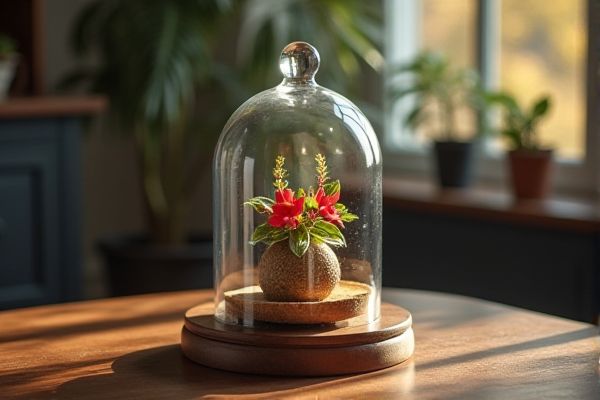
A cloche and a glass dome both protect and display food or decor, but a cloche is typically made of opaque or translucent ceramic or metal, providing insulation, whereas a glass dome offers clear visibility and a more elegant presentation. Discover how choosing between a cloche and a glass dome can enhance your kitchen or event setup by reading the rest of this article.
Table of Comparison
| Feature | Cloche | Glass Dome |
|---|---|---|
| Material | Typically metal or ceramic | Transparent glass |
| Primary Use | Protect plants, especially in gardening | Display and protect decorative items or food |
| Shape | Bell-shaped cover | Rounded dome shape |
| Functionality | Traps heat and moisture for plant growth | Prevents dust and contamination |
| Visibility | Opaque or semi-transparent | Fully transparent |
| Common Size | Varies, generally medium-sized | Ranges from small to large display sizes |
| Use in Food Presentation | Rarely used | Common for covering cakes and pastries |
Introduction to Cloche and Glass Dome
A cloche, traditionally made of glass or plastic, is designed to protect plants or food by creating a mini-greenhouse effect, maintaining humidity and temperature. Glass domes serve a similar protective role but often feature decorative and functional versatility for displaying plants, collectibles, or candles with an elegant, transparent cover. Both items enhance preservation and aesthetic presentation through their unique shapes and materials.
Historical Background: Cloche vs Glass Dome
The cloche originated in 19th century France as a lightweight, bell-shaped cover used to protect delicate plants from frost, enabling early growth in gardens. Glass domes, often referred to as bell jars, have a longer history dating back to the 17th century, serving not only botanical uses but also as display cases for scientific specimens and decorative objects. Understanding the distinct historical background of the cloche and glass dome can help you choose the right protective or display solution for your garden or collection.
Materials Used: Cloche vs Glass Dome
Cloche is typically made of lightweight glass or plastic, providing a practical and affordable option for protecting plants or food, while glass domes are crafted from thicker, high-quality glass that offers enhanced durability and a more elegant appearance. Both materials provide effective insulation and humidity control, but glass domes tend to be clearer and more resistant to scratches or chips. Your choice between the two materials depends on the intended use, whether prioritizing aesthetic appeal or functional durability.
Design and Aesthetics Comparison
Cloche designs often feature classic, bell-shaped forms made from clear glass, offering a vintage charm while allowing full visibility of the displayed item. Glass domes tend to have a more contemporary, sometimes minimalist look with smooth, rounded contours that complement modern decor styles. Your choice between a cloche and glass dome affects the visual impact and style coherence of your space, balancing tradition with modern elegance.
Functional Differences Between Cloche and Glass Dome
Cloche and glass dome both serve to protect and display items, but cloches are typically used in gardening to shield plants from cold temperatures and pests, promoting growth by creating a mini-greenhouse effect. Glass domes primarily function as decorative covers for fragile objects like ornaments, food, or collectibles, offering protection from dust and physical damage while enhancing aesthetic appeal. Your choice depends on whether you need practical plant care or elegant display protection.
Uses in Gardening: Cloche vs Glass Dome
Cloche and glass dome both protect plants by creating a microclimate that retains warmth and moisture, but cloches are typically made of lightweight materials like plastic or fabric, making them ideal for covering individual plants or seedlings in gardens. Glass domes offer superior insulation and durability, suitable for more delicate or temperature-sensitive plants, often used in greenhouses or for decorative indoor gardening. Your choice depends on plant type, climate, and whether you need portability or aesthetic appeal in your gardening setup.
Culinary Applications and Food Presentation
Cloches enhance culinary presentation by trapping steam and heat, which keeps dishes warm and aromatic until served, ideal for souffles and delicate sauces. Glass domes offer superior visibility, allowing chefs and diners to showcase desserts, cheeses, and charcuterie elegantly while protecting them from contaminants. Both tools are essential in fine dining for preserving temperature and visual appeal, but cloches prioritize heat retention whereas glass domes excel in aesthetic presentation.
Durability and Maintenance
Cloche and glass domes differ significantly in durability and maintenance; cloches made from plastic or metal offer more resilience against impacts, while glass domes require careful handling to avoid cracks or breaks. Glass domes provide better clarity but need regular cleaning to prevent smudges and buildup, whereas cloches often require less frequent maintenance but might degrade faster under UV exposure. Choosing your option depends on whether you prioritize long-lasting sturdiness or aesthetic transparency with diligent upkeep.
Price and Availability
Cloche covers are typically more affordable and widely available in various materials like glass, metal, and plastic, making them accessible for different budgets and styles. Glass domes tend to be pricier due to their elegant design and high-quality craftsmanship but offer a sophisticated display option for delicate items. Your choice depends on whether you prioritize cost-effectiveness or a luxurious presentation, considering the availability of each in local stores and online markets.
Choosing Between Cloche and Glass Dome: Which Is Right for You?
Choosing between a cloche and a glass dome depends on your desired aesthetic and functionality; cloches often offer a rustic, vintage charm while glass domes provide a sleek, modern appeal. Cloches typically feature ceramic or metal bases, ideal for protecting plants or food with easy access, whereas glass domes are fully transparent and better suited for showcasing collectibles or delicate items. Consider factors such as air circulation, visibility, and compatibility with your decor to determine which option best suits your needs.
 homyna.com
homyna.com